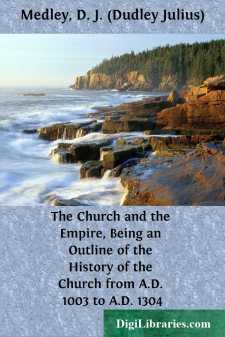Categories
- Antiques & Collectibles 13
- Architecture 36
- Art 48
- Bibles 22
- Biography & Autobiography 813
- Body, Mind & Spirit 142
- Business & Economics 28
- Children's Books 17
- Children's Fiction 14
- Computers 4
- Cooking 94
- Crafts & Hobbies 4
- Drama 346
- Education 46
- Family & Relationships 57
- Fiction 11829
- Games 19
- Gardening 17
- Health & Fitness 34
- History 1377
- House & Home 1
- Humor 147
- Juvenile Fiction 1873
- Juvenile Nonfiction 202
- Language Arts & Disciplines 88
- Law 16
- Literary Collections 686
- Literary Criticism 179
- Mathematics 13
- Medical 41
- Music 40
- Nature 179
- Non-Classifiable 1768
- Performing Arts 7
- Periodicals 1453
- Philosophy 64
- Photography 2
- Poetry 896
- Political Science 203
- Psychology 42
- Reference 154
- Religion 513
- Science 126
- Self-Help 84
- Social Science 81
- Sports & Recreation 34
- Study Aids 3
- Technology & Engineering 59
- Transportation 23
- Travel 463
- True Crime 29
The Church and the Empire, Being an Outline of the History of the Church from A.D. 1003 to A.D. 1304
Description:
Excerpt
Introductory
[Sidenote: Political thought in Middle Ages.]
The period of three centuries which forms our theme is the central period of the Middle Ages. Its interests are manifold; but they almost all centre round the great struggle between Empire and Papacy, which gives to mediaeval history an unity conspicuously lacking in more modern times. The history of the Church during these three hundred years is more political than at any other period. In order to understand the reason for this it will be well at the outset to sketch in brief outline the political theories propounded in the Middle Ages on the relations of Church and State. So only can we avoid the inevitable confusion of mind which must result from the use of terms familiar in modern life.
[Sidenote: Unity of world.]
Medieval thought, then, drawing its materials from Roman, Germanic and Christian sources, conceived the Universe as Civitas Dei, the State of God, embracing both heaven and earth, with God as at once the source, the guide and the ultimate goal. Now this Universe contains numerous parts, one of which is composed of mankind; and the destiny of mankind is identified with that of Christendom. Hence it follows that mankind may be described as the Commonwealth of the Human Race; and unity under one law and one government is essential to the attainment of the divine purpose.
[Sidenote: Duality of organisation.]
But this very unity of the whole Universe gives a double aspect to the life of mankind, which has to be spent in this world with a view to its continuation in the next. Thus God has appointed two separate Orders, each complete in its own sphere, the one concerned with the arrangement of affairs for this life, the other charged with the preparation of mankind for the life to come.
[Sidenote: Relations of Church and State.]
But this dualism of allegiance was in direct conflict with the idea of unity. The two separate Orders were distinguished as Sacerdotium and Regnum or Imperium; and the need felt by mediaeval thinkers for reconciling these two in the higher unity of the Civitas Dei began speculations on the relation between the ecclesiastical and the secular spheres.
[Sidenote: Theory of Church party.]
The champions of the former found a reconciliation of the two spheres to consist in the absorption of the secular by the ecclesiastical. The one community into which, by the admission of all, united mankind was gathered, must needs be the Church of God. Of this Christ is the Head. But in order to realise this unity on earth Christ has appointed a representative, the Pope, who is therefore the head of both spheres in this world. But along with this unity it must be allowed that God has sanctioned the separate existence of the secular no less than that of the ecclesiastical dominion. This separation, however, according to the advocates of papal power, did not affect the deposit of authority, but affected merely the manner of its exercise. Spiritual and temporal power in this world alike belonged to the representative of Christ....


